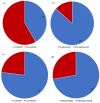Perspectives on the Regional Strategy for Implementation of National Action Plans on Antimicrobial Resistance in the WHO African Region
- PMID: 39452210
- PMCID: PMC11505852
- DOI: 10.3390/antibiotics13100943
Perspectives on the Regional Strategy for Implementation of National Action Plans on Antimicrobial Resistance in the WHO African Region
Abstract
Background: The WHO Regional Office for Africa developed a Member States (MS)-endorsed regional strategy to fast-track the implementation of MS' national action plans (NAP) on Antimicrobial resistance (AMR). This study explored the perspectives of AMR's national focal points in MS on the implementation of the priority interventions of the regional strategy in their countries. Methods: An online survey consisting of ratings and discussions covering the implementation of the six priority interventions was conducted. Sums of the scores per priority intervention were obtained, and their percentage to the total possible scores were calculated to categorize the implementation as inadequate (0-25%), basic (26-50%), intermediate (51-75%), or advanced (76-100%). Results: Thirty-six of the forty-seven national AMR focal points responded to the survey between 12 November 2023 and 8 January 2024. The implementations were rated as 37-62% (basic-to-intermediate), with the multisectoral coordination and collaboration committee receiving the highest overall rating (62%, 421/684), while the promotion of sustainable investment for the NAP on AMR received the least overall rating (37%, 257/700). The focal points mainly recommended awareness campaigns, capacity building, and regulations and guidelines to improve the implementation of the AMR strategy. Conclusions: The survey revealed a need to enhance awareness campaigns, support the establishment and functioning of AMR evaluation and monitoring systems, and build the capacity of AMR staff with cost-benefit analysis and budgeting skills. It also showed the necessity to improve awareness and conduct education on AMR, streamline evidence generation through One Health Surveillance systems, integrate initiatives to reduce hospital-acquired infections in the antimicrobial stewardship programs, and enhance regulations and guidelines to optimize the use of antimicrobials.
Keywords: AMR awareness campaigns; WHO Regional Office for Africa; antimicrobial resistance; antimicrobial stewardship; national action plan; one health; regional AMR strategy.
Conflict of interest statement
D.K. was contracted as an independent consultant by the WHO Regional Office for Africa to conduct the research. All the other authors are members of staff from the WHO Regional Office for Africa.
Figures




Similar articles
-
Moving from assessments to implementation: promising practices for strengthening multisectoral antimicrobial resistance containment capacity.One Health Outlook. 2023 Apr 14;5(1):7. doi: 10.1186/s42522-023-00081-6. One Health Outlook. 2023. PMID: 37055845 Free PMC article.
-
Assessment of Implementation of Antimicrobial Resistance Surveillance and Antimicrobial Stewardship Programs in Tanzanian Health Facilities a Year After Launch of the National Action Plan.Front Public Health. 2020 Aug 27;8:454. doi: 10.3389/fpubh.2020.00454. eCollection 2020. Front Public Health. 2020. PMID: 32974264 Free PMC article.
-
Monitoring progress on Antimicrobial Resistance (AMR) response in the World Health Organization African region: Insights from the Tracking AMR Country Self-Assessment Survey (TrACSS) 2021 results for the human health sector.J Public Health Afr. 2024 Mar 1;14(11):2392. doi: 10.4081/jphia.2023.2392. eCollection 2023 Nov 30. J Public Health Afr. 2024. PMID: 38500695 Free PMC article.
-
Antimicrobial Resistance Rates and Surveillance in Sub-Saharan Africa: Where Are We Now?Infect Drug Resist. 2022 Jul 7;15:3589-3609. doi: 10.2147/IDR.S342753. eCollection 2022. Infect Drug Resist. 2022. PMID: 35837538 Free PMC article. Review.
-
Response to antimicrobial resistance in South-East Asia Region.Lancet Reg Health Southeast Asia. 2023 Oct 29;18:100306. doi: 10.1016/j.lansea.2023.100306. eCollection 2023 Nov. Lancet Reg Health Southeast Asia. 2023. PMID: 38028162 Free PMC article. Review.
Cited by
-
Overview of antimicrobial resistance mitigation efforts in Benin 2024.J Public Health Afr. 2025 Jul 26;16(1):1332. doi: 10.4102/jphia.v16i1.1332. eCollection 2025. J Public Health Afr. 2025. PMID: 40799379 Free PMC article.
References
-
- World Health Organization Priorities on Antimicrobial Resistance. WHO Strategic Priorities on Antimicrobial Resistance: Preserving Antimicrobials for Today and Tomorrow. 2022. [(accessed on 20 November 2023)]. Available online: https://apps.who.int/iris/rest/bitstreams/1409666/retrieve.
-
- O’Neill J. Tackling Drug-Resistant Infections Globally: Final Report and Recommendations. 2016. [(accessed on 20 November 2023)]. Available online: https://amr-review.org/sites/default/files/160525_Final%20paper_with%20c....
Grants and funding
LinkOut - more resources
Full Text Sources
Research Materials

